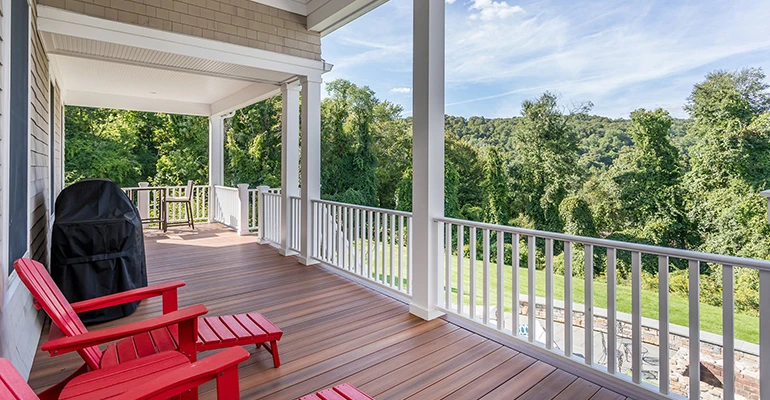Low-maintenance composite decking is becoming a top choice for more and more homeowners. But when summer rolls around, will composite decking get so hot that it burns your feet and makes you have to run inside to be safe? Will it get hotter than a patio or wood deck?
We completely understand your concerns. After all, you will be spending long hours on your deck during the long summer days. If composite decking gets too hot, it will affect your ability to use your outdoor deck. Today, we’ll answer those questions and show you how to keep your deck cool when it’s hot outside.
How Hot Is Composite Decking?
The color of your composite decking boards and whether or not it’s in full sunlight are the two main factors that affect the temperature of your deck. We researched this and found several tests comparing temperature changes between different colors of composite decking, several types of wood, and decking materials.
Test 1: Pressure Treated Wood and Composite Decking at 80°F
In the first test, four different colors of composite decking and two pieces of pressure-treated lumber were exposed to 80° F sunlight for several hours. The test results were as follows.
Composite Decking Boards:
- Light Brown: 93°F
- Medium Brown: 98°F
- Dark Brown: 101°F
- Medium Gray: 95°F
Pressure Treated Wood:
- Unstained: 81°F
- Dark stained: 91°F
It is important to note that these boards were placed on cool grass. As a result, they may not be the same temperature as if they were placed on a deck. Because there is more air movement above the deck, the deck boards will be relatively cooler.
Test 2: Composite Decking and Painted Wood in Temperatures of 86°F
The second test compares a number of different decking materials, but we’ll focus on light brown composite wood decking and painted wood boards, which are very similar in color:
- Painted wood decking: 108°F
- Composite decking: 111°F
Test 3: Testing Paver, Stained Wood, and Composite Decking at 86°F
For our third test, we left composite decking, IPE hardwood, treated yellow pine, and paving stones at 86°F for a full day. The weather was sunny with plenty of sunlight most of the time. Below are the temperatures of the different decking materials.
Composite decking boards:
- Light brown: 135°F
- Medium brown: 137°F
- Medium gray: 135°F
- Dark brown: 148°F
- Dark reddish brown: 147°F
Stained IPE hardwood:
Temperature range for all colors: 136°F to 137°F
Stained and treated yellow pine:
- Clear: 119°F
- Cedar: 122°F
- Redwood: 125°F
- Golden: 128°F
- California Cedar: 130°F
- Russet: 132°F
- Walnut Brown: 133°F
- Slate Gray: 121°F
Paving Stones:
Temperature range for pavers: between 119°F and 126°F
Now that we know how hot wood and composite decks can get, what about concrete and pavers?
Test 4: Different Deck Pavers at 90°F
Different types of pavers will stay at different temperatures in the sun. If you want to find out what the temperature of these pavers will be when they are outside at 90°F, compare them to the two tests above:
- Concrete: 119°F
- Slate: 112°F
- Travertine: 108°F
- Shellstone: 94°F
Note that concrete pavers are usually cooler than poured solid concrete. On hot summer days, poured concrete can reach temperatures of 135°F or more when exposed to the sun. In Arizona, Nevada, and other colder states, temperatures can reach as high as 175 degrees Fahrenheit.
On the other hand, any block made of brick, clay, or other ceramics absorbs and retains heat longer than other materials. On a sunny day with an outside temperature of 100 degrees Fahrenheit, light-colored pavers can reach temperatures as high as 150 degrees Fahrenheit, while dark-colored pavers can reach even higher temperatures.
Will Composite Decking Materials Get Hotter than Wood or Decking?
Wood vs. Composite Decking Boards
As we can see from these tests, unstained or very light-colored wood will be cooler in hot weather. However, the temperature may change depending on the density of the wood.
The difference between polished or painted lumber (which is what you typically see on wood decks) and composite decking boards of the same color is not as great. Typically, the average temperature of the wood is still a bit lower, but the color you choose will have a noticeable effect. You may not be able to tell these temperature differences without testing the temperature with an infrared thermometer.
Comparison of Paving Stones, Concrete and Composite Decking
Brick, clay, and poured concrete are the hottest of all decking materials. They have much higher maximum temperatures than the composite decking materials can withstand.
On the other hand, slate, travertine, and shellstone are about as hot as wood or composite decking materials. However, they may also get hotter or colder depending on the situation.

